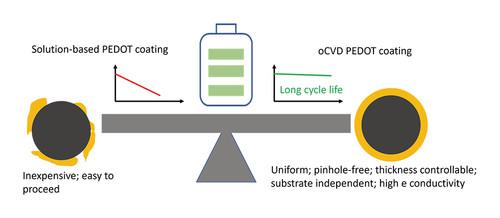A Review on Application of Poly(3,4-ethylenedioxythiophene) (PEDOT) in Rechargeable Batteries
引用次数: 0
Abstract
Since the very first patent on poly(3,4-ethylenedioxythiophene) (PEDOT) that was filed in 1988, this polymer has been widely utilized and has achieved great success owing to its high electrical conductivity and excellent stability. The application of the conducting polymer, PEDOT, in renewable energy devices, especially rechargeable batteries, is attracting increasing attention due to its potential to solve the energy and climate crisis. In this review, we summarize the research over the past few decades directed toward the application of PEDOT in rechargeable batteries aimed at improving their electrochemical performance. We focus on PEDOT synthesized via oxidative chemical vapor deposition (oCVD), a relatively new process known for its ability to grow conducting polymer thin films with uniform, pinhole-free properties, and controllable thickness and conformality. For a comparison purpose, PEDOT synthesized via solution-based methods is also briefly summarized. Finally, future research directions for applying oCVD PEDOT in rechargeable batteries are discussed.

聚3,4-亚乙基二氧噻吩(PEDOT)在可充电电池中的应用综述
自1988年提交关于聚(3,4-亚乙基二氧噻吩)(PEDOT)的第一个专利以来,这种聚合物由于其高导电性和优异的稳定性而被广泛使用并取得了巨大成功。导电聚合物PEDOT在可再生能源设备,特别是可充电电池中的应用,因其解决能源和气候危机的潜力而越来越受到关注。在这篇综述中,我们总结了过去几十年来PEDOT在可充电电池中的应用研究,旨在提高其电化学性能。我们专注于通过氧化化学气相沉积(oCVD)合成PEDOT,这是一种相对较新的工艺,以其生长具有均匀、无针孔特性、厚度和构象可控的导电聚合物薄膜的能力而闻名。为了进行比较,还简要总结了通过基于溶液的方法合成的PEDOT。最后,讨论了oCVD PEDOT在可充电电池中应用的未来研究方向。
本文章由计算机程序翻译,如有差异,请以英文原文为准。
求助全文
约1分钟内获得全文
求助全文

 求助内容:
求助内容: 应助结果提醒方式:
应助结果提醒方式:


